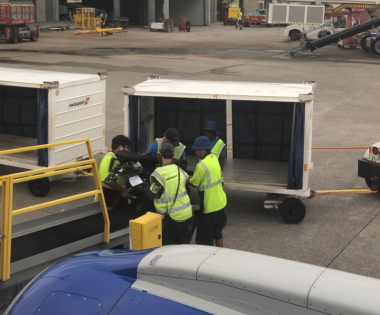How to Enjoy Travel With Duchenne Muscular Dystrophy

Last week, I traveled to the headquarters of my employer, Bionews, the publisher of Muscular Dystrophy News Today. The trip took me from Newport Beach, in Southern California, to Pensacola, in the Florida Panhandle. While it was an interesting experience, it wasn’t without its challenges, especially with Duchenne muscular dystrophy and a power wheelchair.
I wrote about traveling with a disability for The Washington Post a couple years ago. In the article, I talked about how I’ve been able to visit 13 countries despite having Duchenne, and I interviewed others who use a wheelchair about the best way to plan ahead for a trip.
Even with all the planning in the world, things can still go south at any moment. And as my Duchenne progresses, some of my abilities lessen and I need more help. As people with disabilities, if we can stay calm, ask for help, and plan ahead, and if the airline, hotel, and tourism industries can make a concerted effort to make their businesses accessible, then traveling with a wheelchair can become a reality for many more people.
Let’s start with the travel industry — specifically airlines, because they require us to have patience from the outset, and they contribute to an ableist society.
One can’t overlook the airlines’ dismal record of handling power wheelchairs. According to a recent MSNBC opinion piece, staff at various airlines reportedly broke 10,548 wheelchairs or scooters in 2019. That’s more than one out of every 100 that entered an airplane’s cargo deck, opinion columnist Liz Plank noted.
I can attest to this point from personal experience. My parents and I have long been afraid to take my new Permobil F5 power wheelchair on a plane, braving only trips to and from Washington, D.C. We caught a break there. The rest of the time, we either used a scooter, or more recently, a smaller, portable travel power wheelchair that doesn’t have all the features I need to lead my life.

Baggage handlers manhandle my power wheelchair at the airport during a recent trip. (Photo by Hawken Miller)
But on this trip to Pensacola, we used my old, ratchety powerchair, which was already pretty beat up, because we know that baggage handlers treat a person’s arms and legs (their wheelchair) the same as someone’s $20 duffel bag. At the Pensacola airport, I peered out the window to see airline workers perform a glorified drop of my chair.
While nothing was broken, the joystick on my chair, the most important part, had hit against the inside belly of the plane so many times it wouldn’t straighten out afterward, forcing me to maintain my arm in an awkward position. That was enough to cause me to swerve and generally be uncomfortable.
You might think I’m complaining about something minor, but if you’re a physically able person, standing is what our bodies are designed for, not sitting all day. It’s important for our chairs to mold to us as closely as possible, and manhandling a wheelchair is not going to help.
I’m grateful I’m able to use a secondary power wheelchair or travel wheelchair, and my dad can help carry me if needed, but not everyone has that luxury. Airline workers need training on how to lift power wheelchairs and should be punished if they cause a problem. Ruining a person with a disability’s sole chance to enjoy traveling should not be normalized.
Hopefully, airlines can change the way they do things, but we can also change the way we react to unsatisfactory travel experiences. If your chair breaks, you encounter an impassable step, or someone treats you as subhuman, the only thing you can control is your reaction. Getting upset won’t help anything, and it can also cloud your judgment, making things worse.
I’ve written about this before, but asking for help from strangers is an important skill to have. It means embracing discomfort. Most of the time, people are willing to help get you through a tough travel situation. And hospitality staff is there to make your stay pleasant. They won’t know you need something until you communicate it and advocate for yourself.
Finally, as the Boy Scout motto says, be prepared. Call for accessible transit ahead of time, look at the Google Street View of your hotel and search for ramps, and locate the closest hospitals in case the worst happens. Of course, being spontaneous is always fun and can still happen on an accessible trip. But get the basics down first.
Traveling should not be so difficult for people with disabilities. Millions of people are missing out on the joy of experiencing a new destination for the first time. But the good thing is it can be better, both in the way the vacation industry treats us and the way we respond to challenges.
***
Note: Muscular Dystrophy News is strictly a news and information website about the disease. It does not provide medical advice, diagnosis or treatment. This content is not intended to be a substitute for professional medical advice, diagnosis, or treatment. Always seek the advice of your physician or another qualified health provider with any questions you may have regarding a medical condition. Never disregard professional medical advice or delay in seeking it because of something you have read on this website. The opinions expressed in this column are not those of Muscular Dystrophy News or its parent company, Bionews, and are intended to spark discussion about issues pertaining to muscular dystrophy.








Joe Pierce
Very interesting, thanks Hawken!